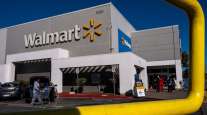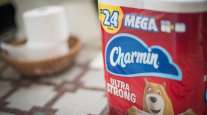Holiday Sales Seen Rising 4.1% on Employment Gains
U.S. retail sales this holiday season may rise the most in three years as the improving employment picture gives more shoppers the means to splurge on gifts, the National Retail Federation said.
Purchases may advance 4.1% to $617 billion in November and December, the Washington-based NRF said Oct. 7 in a statement. The increase would top last year’s 3.1% gain and the 10-year average of 2.9%, the trade group said.
Steady employment gains are giving more consumers the wherewithal to buy presents this year and helping others feel secure enough in their jobs to spend more. Even so, stagnant wage growth has kept many shoppers reliant on markdowns and may prompt retailers to offer steep discounts, just like they did last year, when a government shutdown and extreme weather kept some consumers at home.
“The ability for consumers to spend is there,” Jack Kleinhenz, chief economist at the NRF, said in an interview. “Retailers have conditioned consumers into looking for bargains. There are a lot of concerns out there, but putting those aside, if we don’t have any unusual factors like last year, it’s going to be a solid year.”
Online sales may rise as much as 11% to $105 billion in November and December, the NRF’s shop.org arm projected. That would be greater than the 8.6% sales growth last year.
Some consumers are starting early to get the best prices. Gena Shelton, a 34-year-old mother of one who lives in Columbus, Ohio, said she’s almost a third of the way through her holiday shopping list already. Shelton bought a new house with her husband in May and said she plans to keep her gift budget the same or smaller than last year.
“The reason I’m shopping more ahead than I normally do is that I would like to spend less,” said Shelton, who looks for coupons and savings codes online to stretch her dollars. “They don’t know if you bought that Disney princess 70% off or for full price.”
Consumer spending, which accounts for almost 70% of the U.S. economy, has been seesawing in recent months as Americans grapple with sluggish wage growth. After adjusting for inflation, purchases climbed 0.5% in August, the biggest gain in five months, according to figures from the Commerce Department. That followed a 0.1% drop the prior month.
Big-ticket items such as automobiles have led the gains as low interest rates and discounts prompt households to replace older models. Cars and light trucks sold at an average 16.7 million annualized rate from July through September, the best performance for any quarter since the first three months of 2006, according to industry data.
While spending is climbing, uneven progress in the labor market is holding back a more pronounced rebound. The jobless rate fell to a six-year low of 5.9% in September as employers hired more workers than most economists forecast, the Labor Department reported last week.
The increase in jobs has so far failed to generate bigger pay increases as earnings per hour were little changed on average last month from August, the figures showed. Over the past 12 months, wages were up 2%, compared with a 3.1 % increase in the year ended December 2007, when the last recession began.
This year’s back-to-school season, often seen as a harbinger for the holidays, was the slowest since the recession ended in 2009. Spending in the period rose 3.1%, missing a forecast for a 3.2% gain, according to research firm Customer Growth Partners LLC. Another sobering sign: Store traffic declined 4.2% in July and slipped an additional 4.7% in August, according to ShopperTrak, a Chicago-based research firm.
The NRF’s holiday estimate is in line with a projection from Deloitte LLP, which said last month that sales in stores may increase 4.5% in the period November through January. Online and mail-order sales may climb as much as 14% in that time, the New York-based consulting firm said. The NRF last year forecast a 3.9 % increase in holiday sales, overshooting the final results by 0.8 percentage points.




